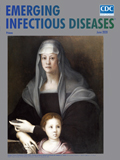
Volume 26, Number 6—June 2020
Dispatch
Cannabis Use and Fungal Infections in a Commercially Insured Population, United States, 2016
On This Page
Tables
Downloads
Altmetric
Abstract
Case reports have identified invasive fungal diseases in persons who use cannabis, and fungal contamination of cannabis has been described. In a large health insurance claims database, persons who used cannabis were 3.5 (95% CI 2.6–4.8) times more likely than persons who did not use cannabis to have a fungal infection in 2016.
Cannabis can contain fungal pathogens that cause serious and often fatal infections in persons with immunocompromising conditions, such as cancer, transplant, or infection with HIV (1). In these patients, some reasons for using cannabis include pain and nausea relief and appetite stimulation. The frequency of fungal infections associated with cannabis is unknown but is a growing concern as more states legalize its medicinal and recreational use. We used health insurance claims data from 2016 to evaluate the prevalence of fungal infection diagnosis codes among persons who use cannabis and persons who do not use cannabis and to compare demographic and clinical features between these 2 groups.






















.png)











No hay comentarios:
Publicar un comentario